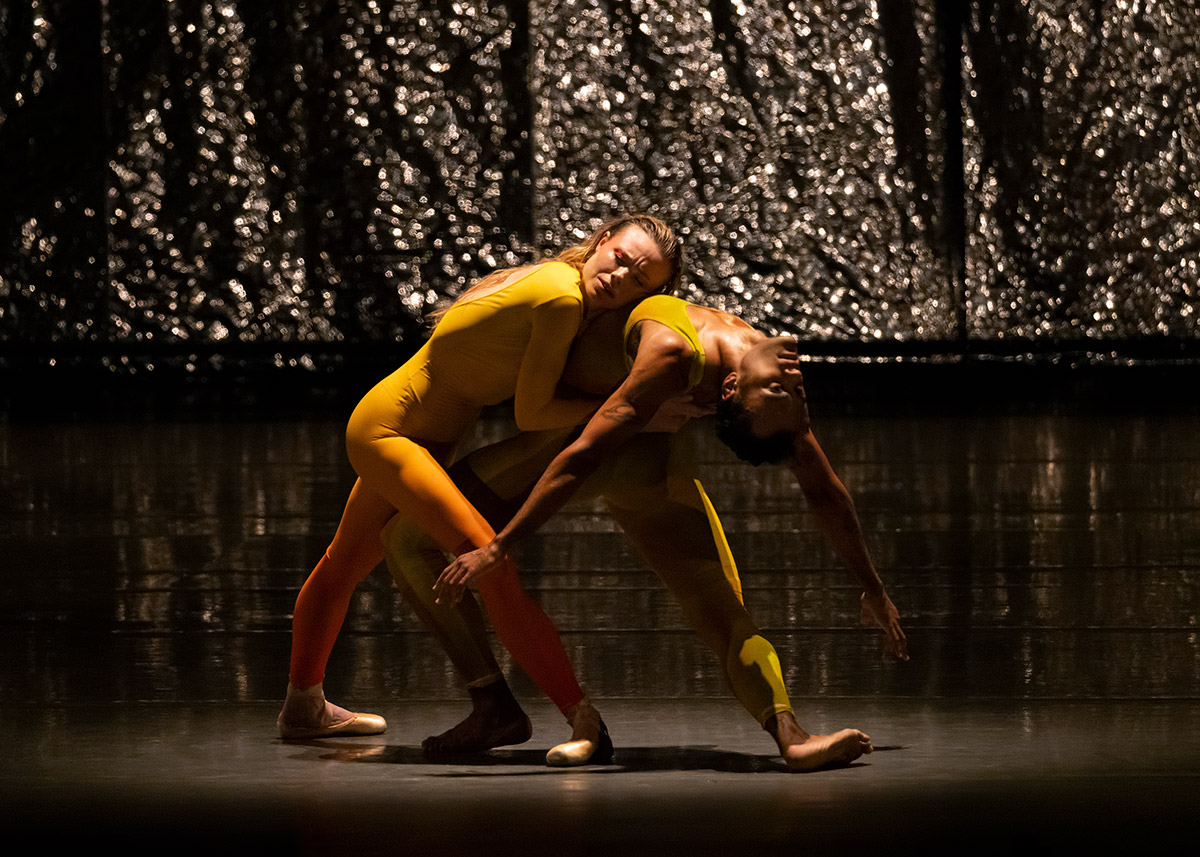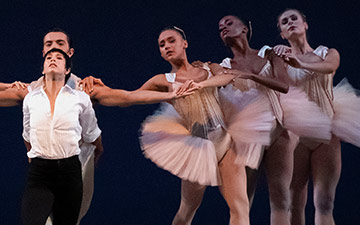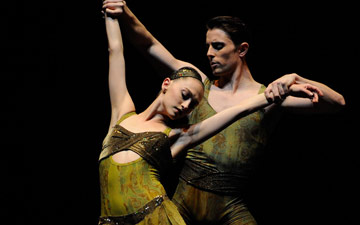
© Erin Baiano. (Click image for larger version)
New York City Ballet
Fall Fashion Gala: Glass Pieces, Suspended Animation, sky to hold
★★★✰✰
New York, David H. Koch Theater
30 September 2021
nycballet.com
davidhkochtheater.com
Fall Colors
The Fall Fashion Gala has become a staple at New York City Ballet, a siren song to the well-heeled, who show up in their fineries year after year. It’s also a big money-maker, a not insignificant fact after a year of closed theaters and lost revenue. The gala portion of the evening this year was held outdoors, on the plaza. Indoors, two new ballets, by Sidra Bell and Andrea Miller, clothed by the designers Christopher John Rogers and Esteban Cortázar, were being premiered. As always, Mark Happel’s wardrobe shop at New York City Ballet has been hard at work. Happel, featured in a well-made introductory film, pointed out how difficult it can be to adapt fashion designers’ ideas for the stage. As he said, “you have no idea.”
And yet, over time, the misses have been more numerous than the hits at the fall gala, although a few memorable pieces remain, most notably Kyle Abraham’s The Runaway and Justin Peck’s Pulcinella Variations. The latter, one of Peck’s most stylish and ebullient pieces, is back this season, with its witty, commedia-dell-arte inspired designs by Tsumori Chisato.
This year’s edition falls somewhere in the middle. Neither Bell nor Miller hit it out of the park, and neither piece seems likely to stay in the repertory for long. But both used the costumes well, creating distinct atmospheres and moods. Despite dim lighting, both were bathed in deep, rich, saturated colors, a welcome change from the drab palette of so much contemporary ballet. Both created spaces in the imagination, though neither managed to carry through or develop their ideas in interesting ways. Both suffered from a feeling of formlessness.

© Erin Baiano. (Click image for larger version)
Suspended Animation, by Sidra Bell, a longtime choreographer with her own ensemble, Sidra Bell Dance New York, created a kind of space-age, high-fashion nether world in which the dancers existed in splendid but melancholy isolation. Bathed in the rich cello melodies of Dosia McKay’s Is Now Not Enough, they materalized onstage, lit from above, in their fantastical costumes. Megan LeCrone looked like a gorgeous green mushroom, tendu-ing and flicking her feet in the light. Harrison Ball, in a fuchsia corset and sparkles, undulated fluidly in his spotlight at the rear of the stage, partly obscured by a black panel. Each seemed shut off, as if dancing for themselves.
There was a suggestion of period dress, and, at some point, the possibility that it might lead into some sort of short story, but the illusion quickly faded. The costumes, by Christopher John Rogers (who has dressed Beyoncé and Kamala Harris) were the true star of the ballet. The dance was full of little ideas, but, lacking sense of direction or momentum, it simply floated, handsomely, in the spacey, sometimes sentimental flow of its music, a combination of works by Oliver Davis, Nicholas Britell, and Dosia McKay.

© Erin Baiano. (Click image for larger version)
Andrea Miller’s sky to hold had more energy and more impetus. The beginning, in particular, had a stormy force reminiscent of fantasy novels and films like Lord of the Rings or Game of Thrones. Dancers in rippling silks ran around the fog-filled stage like fairies or spirits. Then Sara Mearns appeared, an unstoppable sorceress waving her arms, swooping through the air. She was the mother of dragons, and her offspring, it seemed, was Taylor Stanley, dancing the role of a shape-shifting creature who moved with the mutability of mercury. For both Mearns and Stanley, Miller, who comes from the world of modern dance and was a member of Ohad Naharin’s Batsheva, has crafted highly individualized movement that makes use of their very individual qualities. The solos for Stanley are particularly stunning, full of buckling limbs, squats, and rippling cross-currents. They are so specific to him that it is difficult to imagine any other dancer performing them. For Chun Wai Chan, a former Houston Ballet dancer who has just joined the company, there were heroic lifts, and leaps, revealing a dancer of sleek power and excellent partnering abilities, something NYCB can definitely use more of.
Eventually, with the arrival of the singer and composer Lido Pimenta onstage, the action seemed to shift away from the earlier dramatics toward a celebration of the forces of nature, with hints of the Rite of Spring (though without the violence). In a duet, Mearns and Taylor were like Adam and Eve, two halves of the same being, separating and merging into one another. As Pimenta’s voice whooped and keened – she is half-Colombian and makes references to indigenous music – the dancers gathered in clusters and flitted across the stage like bounding creatures in the garden of Eden. “Busca la luz,” look for the light, Pimenta intoned, over and over, and they did.

© Erin Baiano. (Click image for larger version)
But even though engrossing in moments, sky to hold didn’t hold together, partly because its vocabulary of movement, excluding the choreography for Mearns and Stanley, was rather thin. But also because the dramaturgy felt muddled. Where Suspended Animation is static, sky to hold meanders.
The evening opened with a performance of Glass Pieces, by Jerome Robbins, in which the central pas de deux was performed by Maria Kowroski and Amar Ramasar. It is a great role for Koworski, who dances its long, legato phrases with a kind of regal sadness that perfectly suits the Egyptian frieze-like choreography. Every performance this season, her last with the company, suggests a tightly controlled but powerful emotional charge.
Fashion may not be the best impetus for great ballets, but at least on this occasion, the costumes added greatly to the visual pleasure of the evening. Color, movement, and the imagination are always welcome.

















You must be logged in to post a comment.